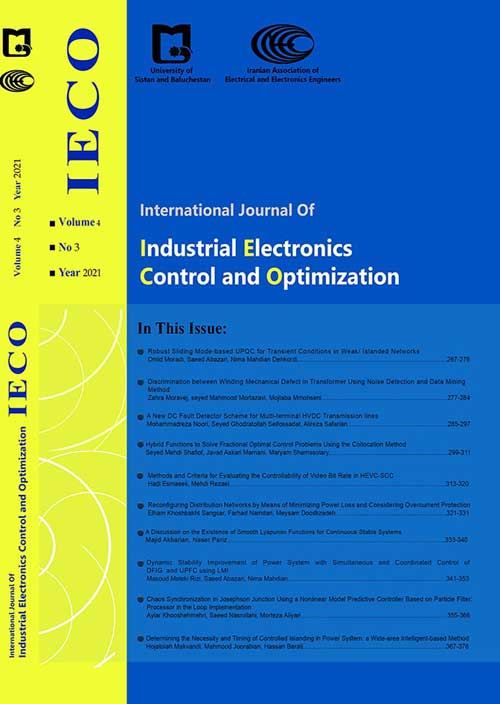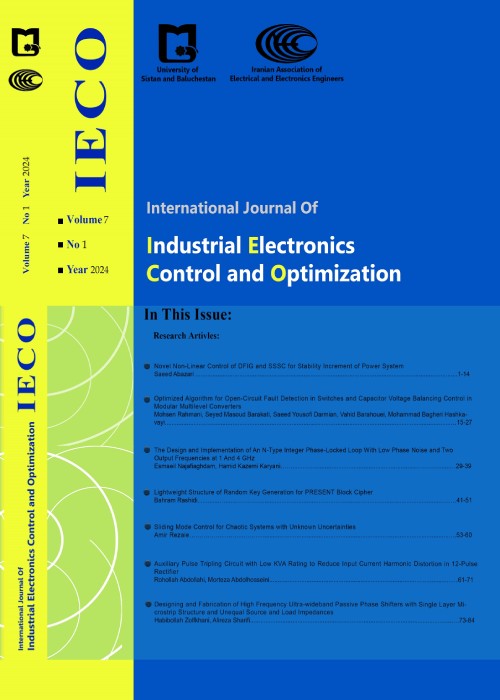فهرست مطالب

International Journal of Industrial Electronics, Control and Optimization
Volume:4 Issue: 2, Spring 2021
- تاریخ انتشار: 1400/06/06
- تعداد عناوین: 10
-
-
Pages 141-155Conventional energy storage systems (ESSs) such as super-capacitors and lithium-ion batteries require voltage equalization systems to eliminate voltage imbalances, and bidirectional dc-dc converters to complete the charging process. These separated systems require some sensors, inductors, switches, and transformers. Consequently, the ESSs volumes, prices, and their complexity are dramatically increased by increasing the required series connected batteries count. Here, a self-equalized battery charger is proposed for lithium-ion batteries by combining a voltage multiplier (VM) and a phase-shifted full-bridge (PSFB) dc-dc converter. In the proposed self-equalized battery charger, the voltage multiplier eliminates the voltage imbalances and the PSFB dc-dc converter carries out the charging process. By combining the voltage equalizing and the charging systems into a single system, an integrated converter is obtained which leads to simultaneous charging and equalization operations, power and control sections simplicity, as well as low volume and price. By utilizing the phase-shift control method, zero-voltage-switching (ZVS) operation of power MOSFETs is obtained which leads to high efficiency and low EMI noise. The experimental results for 8 battery modules including 48 lithium-ion cells, are in good agreement with the given mathematical analyses and simulations and clearly show the simultaneous charging and voltage equalizing operations, as well.Keywords: Energy Storage System, Equalization, Phase-Shifted Full-Bridge DC-DC Converter, Voltage Multiplier, Zero-Voltage-Switching (ZVS)
-
Pages 157-165Nowadays, rehabilitative robots that have received more attention in the field of rehabilitation can help patients in the rehabilitation training and reduce therapist workload. This paper suggests the use of surface electromyography (sEMG) signals and a bidirectional neural network (BRNN) for the estimation of the joint angles of lower limbs. The input of BRNN is the preprocessed sEMG signals and its outputs are the estimated joint angles of knee, ankle and hip. In order to prove the usefulness of the bidirectional neural network, four normal and healthy subjects and two spinal cord injury (SCI) patients take a part in the experimental tests. The healthy subjects exercise two movement modes containing the leg extension and the treadmill at various loads and speeds, while the SCI subjects conduct only the treadmill exercise. In order to record useful information, seven leg muscles were used and then the hip, knee and ankle joint angles were acquired at the same time. The experimental results show the satisfactory performance of the proposed method in the estimation of joint angles by employing surface electromyography signals for both groups. The proposed estimation method can be used for controlling the rehabilitation robot of SCI subjects based on sEMG signals.Keywords: joint angle estimation, sEMG signals, rehabilitation robots, bidirectional recurrent neural network
-
Pages 167-179
In power converters, the total harmonic distortion (THD) can be decreased by using two strategies which are filtering and controlling methods. The filtering strategy is indeed costly because of using hardware devices (such as capacitor and inductor). A suitable strategy to control the modern power converters without using the hardware devices is the pulse width modulation (PWM) technique. In this paper, three new PWM control methods based on mathematical equations for various Z-source inverters (ZSIs) are proposed. Controlling the duty cycles of switches is the basic idea of these methods to control the output voltage. The proposed control methods are analyzed under the circumstances of constant input and balanced output voltage (CIBOV) and ripple input and balanced output voltage (RIBOV). The advantages of proposed methods are control of voltage, current and harmonic distortion. Other advantages of these methods are lower value for THD and elimination of low-order harmonics. The correctness operation of the proposed PWM techniques is proved by using the simulation results.
Keywords: Pulse width modulation (PWM), Quasi-Z-source inverter (qZSI), Shoot-through (ST) state, Total harmonic distortion (THD) -
Pages 181-190In this paper, RF source localization in non-line of sight condition, using map of the obstacles is proposed. Received signal strength indicator (RSSI) and angle of arrival (AOA) measurements are observations which are obtained from received signal on the UAV. In the proposed approach, AOA are used to determine the obstacle on the map from which the reflection has happened. Then the RSSI information is used to determine the location of the RF source. In the basic version of approach, triangulation is used to determine the location of the RF source. In the advanced approach, the reflection angle is also estimated to improve the localization accuracy. The estimation is done using particle filter approach. In addition, it is shown analytically that the maximum localization error for the advanced approach is bounded but relative formation of the reflectors with respect to each other can increase the localization error for the basic approach.Keywords: RSSI, Obstacle Map, UAV, Particle filter
-
Pages 191-210Secure and economical operation of distribution networks needs the management of reactive power resources. Optimal Reactive Power Dispatch (ORPD) optimally manages the reactive power scheduling of generators and distribution generations as well as the Reactive Power Compensation (RPC) devices. This paper investigates the effect of load models on the multi-objective ORPD problem in active distribution networks. Moreover, a modified Grey Wolf Optimizer (GWO), which is called in this paper as Civilized GWO (CGWO), is introduced to solve the ORPD problem. The proposed strategy including multi-objective function, various load models, DG’s reactive power, RPCs and the introduced CGWO, is tested on standard IEEE 33- and 69-bus distribution systems. The obtained results indicate the load models have significant impact on the cost function amount. Moreover, the performance of the proposed algorithm is evaluated using ten standard benchmark functions. The optimization results demonstrate the robustness of the introduced optimization algorithm and its ability in finding the better solutions compared to the Particle Swarm Optimization (PSO), Exchange Market Algorithm (EMA), and original GWO.Keywords: Civilized grey wolf optimizer, load modelling, Multi-objective optimization, optimal reactive power dispatch
-
Pages 211-220The changes in the crude oil flow rate to an atmospheric distillation unit can influence the quality of the products. This paper presents a modification method for soft sensing model including an update term, which makes it compatible with industrial variations. A modified soft sensing structure is adopted using lookup table (LUT) method where steady-state soft sensing models are performed. The steady-state soft sensing models is proposed based on local instrumental variable (LIV) technique for an industrial atmospheric distillation unit (ADU) at Shiraz refinery, Iran. The LIV-based soft sensors are utilized tray temperature measurements to monitor ASTM-D86 index of side products for nominal flow rate (60,000bbl/day). Lookup tables have been developed based on the difference between the predicted values of ASTM-D86 index and corresponding simulation values to make update terms in different feed flow rates. The results present improvement in the predictions of LIV-based soft sensors as well as acceptable control performance in feed flow rate variations. The comparison of soft sensing results with/without lookup tables demonstrates that the proposed update term helps to predict product quality more precisely and is suitable for advanced monitoring scheme due to no complexity and low computational time.Keywords: Data-driven soft sensor, Local instrumental variable (LIV), ASTM-D86 index, Crude oil distillation column, Lookup table method
-
Pages 221-234The Economic Dispatch (ED) is one of the most important optimization problems in power systems the ultimate goal of the ED is to minimize the cost of operations in a power generation. In this paper, the Woodpecker Mating Algorithm (WMA) is used to solve the ED problem considering the nonlinear properties of generators such as valve point effects (VPE), prohibited operating zones (POZ), ramp rate limits, multiple fuel options, and transmission loss. The WMA algorithm is a novel metaheuristic algorithm inspired by the mating behavior of woodpeckers and sound intensity (a physical quantity). The WMA is implemented on six test systems of different operational dimensions and characteristics to show its capacity for solving the ED problem. The results are compared with the latest and most efficient methods introduced in the literature. Proving the efficiency of the WMA to solve the ED problem, simulation results are promising and offer the optimal fuel cost of production.Keywords: Woodpecker Mating Algorithm, Economic dispatch, Valve Point Effects, Nonlinear optimization
-
Pages 235-244One of the important issues in designing high-performance brushless direct current (BLDC) motors is reducing the cogging torque since it results in mechanical vibration, audible noises, and torque ripples, which adversely impact the performance of the motor, which is awkward high-accuracy applications. This paper proposes an optimum design for BLDC motors aimed at reducing the cogging torque based on the capability of metaheuristics algorithms in finding the optimal solution. For this purpose, a simplified cogging torque equation is used as the objective function whose design variables include air gap length, magnet height, slot height, slot opening, and motor axial length. These are the five most influential parameters of cogging torque. On the other hand, we employ not only the old metaheuristics algorithms like the Genetic Algorithm (GA) and Simulated Annealing (SA) but also more recent algorithms such as Keshtel Algorithm (KA) along with the hybrid ones to benefit from their strength. The simulation is performed in the Matlab package. First, five selected optimization algorithms are applied and the results are investigated. The results of all the algorithms show a significant reduction in the cogging torque. Eventually, the proposed algorithms are compared to one another in terms of their value of cogging torque. The results show the superiority of the KASA algorithm in comparison with the others.Keywords: Brushless DC motors, Cogging torque, Design, Metaheuristics algorithms, Optimization
-
Pages 245-255This article addresses the optimal energy management and operation of networked microgrids considering different types of dispatchable units like fuelcell and microturbine and nondispatchable units such as wind turbine and solar units. To change the just-consuming role of vehicles into an active role with the ability of making profit, the vehicle-to-grid technology (V2G) is deployed here. Due to the complex and nonlinear structure of the problem, an effective optimization energy management framework based on the bat algorithm (with a modification) and unscented transform is devised to find the most optimal operation point of the devices from the economic point of view. Due to the high uncertainties injected by electric vehicles pattern behavior in addition to the renewable sources output power variations, the unscented transform is proposed to make the analysis more realistic. The simulation results on an IEEE networked microgrid test system advocate the high capability and proper performance of the proposed method. The results show that the total system operation cost is 53897.004$ and 53711.704$ in the 1st and 2nd scenarios, respectively. Moreover, it is seen that considering uncertainty in the problem has added 0.586% and 0.762% to the cost function value in the first and second scenarios, compared to the deterministic framework.Keywords: Smart Grid, Energy Management, Battery, Micro-turbine, Fuel Cell
-
Pages 257-266
An Electric Vehicle Battery Charger (EVBC) faces serious challenges as continuous charging voltage ripple, charging speed, input voltage level variations, and its ability to adapt to the Battery State of Charge (BSOC). A proper controller has an important role to prepare all the mentioned above. A nonlinear one such as sliding mode controller (SMC) is eminently suitable for solving these issues. Therefore, an improved SMC, to take control of a DC/DC boost converter as an EVBC, is presented in this work. This proposed controller has a more robust structure in the input voltage significant variations than the other SMCs. Therefore, this provides the capability to apply various kinds of power supplies as input voltages in EVBC stations. The EVBC power and battery voltage/capacity are assumed 14 kW and 400V/60Ah, respectively in this converter. The simulation results in Matlab Simulink verify the controller’s high performance compared with the other SMCs.
Keywords: Battery State of Charge (BSOC), Electric Vehicle Battery Charger (EVBC), Mean Displacement Error (MDE), Renewable Energy Source (RES), Sliding Mode Controller (SMC)


